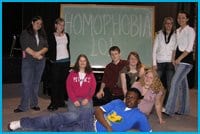Seventy-four teachers sit in chairs facing the front of the auditorium being schooled by students. The students are confident and well-prepared — they distribute multiple hand-outs, move through a Power Point presentation and then present a skit before inviting questions. It takes guts to explain that “smoking pole” means “oral sex on a man” to this crowd, but Nicole Guarascia wants to make sure that the next time a teacher hears that phrase they understand it, recognize it’s often homophobic and do something.
The teachers are learning about human rights and homophobia in their schools as part of Halton Organization For Pride And Education (HOPE)’s Beyond Homophobia: Strategies For Change, Educating Our Educators Project. It’s a case of the students educating their educators, and Burlington is becoming more accepting and supportive as a result. I’ve been a resource and a support for the students while they developed their presentation, now I’m in the background and, like the teachers, watch.
HOPE chair Marcus Logan says the project came out of earlier work in Halton schools.
“Students repeatedly said they need teachers to respond to homophobia, they felt teachers were not addressing the issue,” says Logan. HOPE formed a partnership with the Halton District School Board, secured funding through the National Crime Prevention Strategy and started the project in the fall of 2005.
Ten Burlington students of all orientations represent four high schools involved in the project. Aged 15 to 18, they are united in the belief that homophobia is a problem in their schools and by working together and with their teachers they can make a difference.
“I came out because I recognize the growing problem in high schools, the ignorance, lack of understanding. It’s something I really want to change,” says member Rachel Shoup. “For me, this is just the start. I’ll be able to continue working on these issues in school and the community.”
The students attended eight weekly training sessions, learning about topics such as gender identity, queer rights in a global context and homo history. It was the history they were most interested in.
“They don’t teach us this in school,” says Sarah King.
Jessica Sissons says her school has had a number of assemblies addressing bullying, but never once mentioned homophobia. It made her mad and provoked her to work for change.
The students assessed the school climates, including scouting out and photographing homophobic graffiti. Even they were surprised at how much there was.
“It’s often in places teachers don’t look, like student bathrooms, inside desks, inside text books and smoking areas,” says Cassie Van Oort. “Often teachers would do nothing even if you told them about it.”
Much of the graffiti targeted individuals by name, which especially bothers Van Oort; her ex-boyfriend came out as gay and was so harassed by other students that he made several suicide attempts. For Van Oort, this work is about saving lives.
The group also surveyed their peers. About 98 percent of students reported hearing homophobic comments on a weekly basis. About 33 percent reported hearing more than 20 homophobic comments per week. More than 20 percent reported hearing homophobic comments from their teachers. While many students said homophobia bothered them, most said they were too afraid of becoming a target themselves to do anything about it.
Students in the group know this from their own experience. Nevena Postran, who’s straight, says that while conducting the survey, other students asked if she was a lesbian and targeted her with homophobic comments.
So why do it?
“Diversity makes this world so beautiful, it’s about human rights and justice,” says Postran, who came to Canada as a refugee. “I’m done with tolerance. We need acceptance.”
At the presentation, the students present their findings to teachers using clear language, including a primer on queer vocabulary.
One teacher says he doesn’t know any gay students.
“Is homophobia really a big issue when there are so few gay students?” The students tell him that homophobia is a huge problem, causing many students to be too afraid to come out. They assure him that he does know gay, lesbian and bi students, and they ask him to think about why those students don’t feel safe enough to be out in his classes. He quiets down, but keeps listening.
In the second part of the presentation they help teachers build skills on how to respond to homophobia. They ask teachers to learn three Rs of homophobia: recognize, respond and reconstruct (that is prevent), and they make them practice. That’s their base line, though they invite teachers to “go above and beyond,” to create safe spaces in schools, by doing things like helping create gay-straight alliances and including queer-oriented material in their lesson plans. Currently no Burlington high schools have gay-straight alliances.
The teachers seem engaged with the material. They shout “Stop” at homophobic moments in the skit. They laugh at the jokes and admit they are still learning. Many voice frustrations.
“Many senior teachers don’t act when GLBT [gay, lesbian, bisexual and trans] rights are infringed,” says one. “I’ve personally seen them turn a blind eye.”
“Homophobia is ignored in our school,” says another. “Nothing is done here.”
Afterward, the students pack up their materials. They’ve now presented to the entire teaching staff at three Burlington high schools with three more to go. They are upbeat and keen to talk about what they’ll do next. They have no plans to stop.

 Why you can trust Xtra
Why you can trust Xtra


